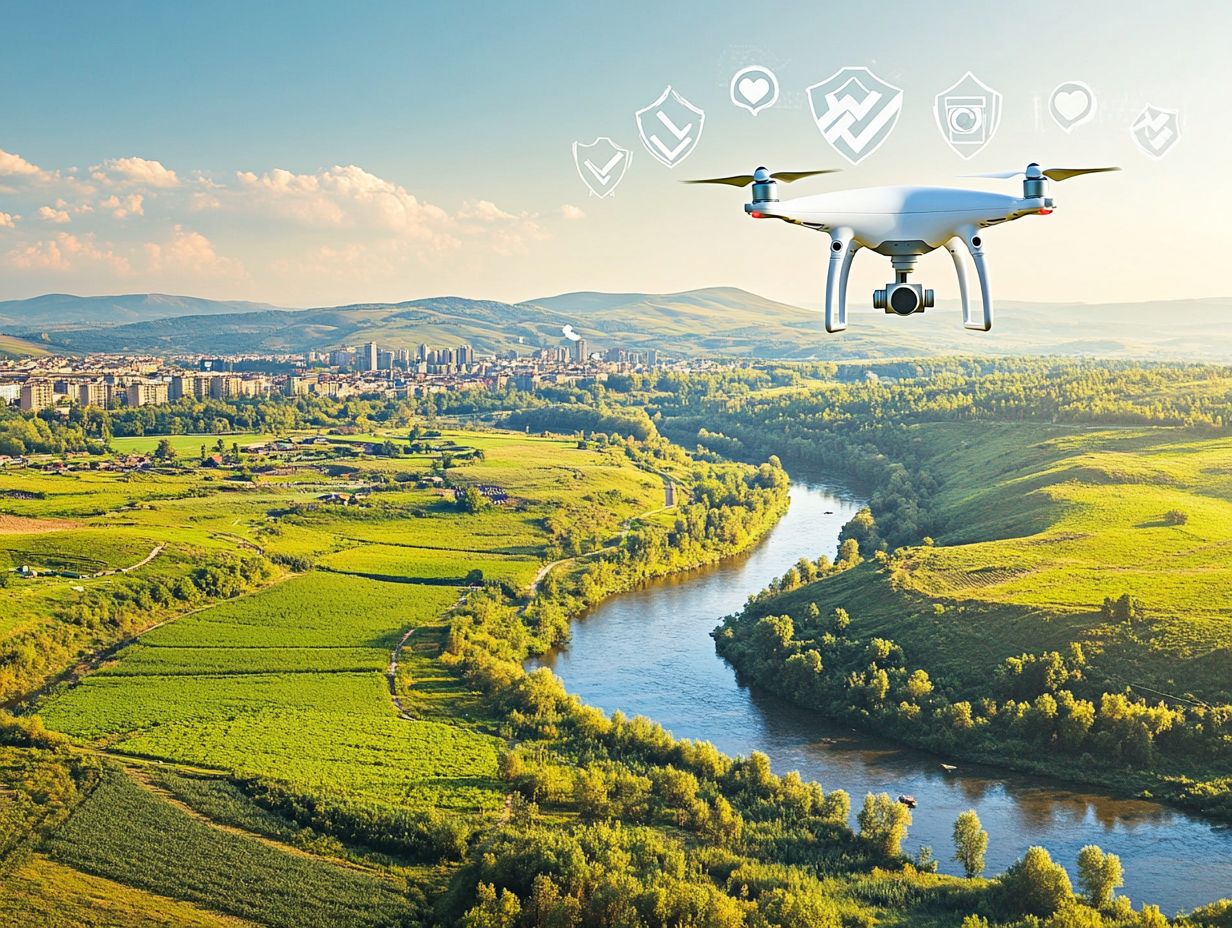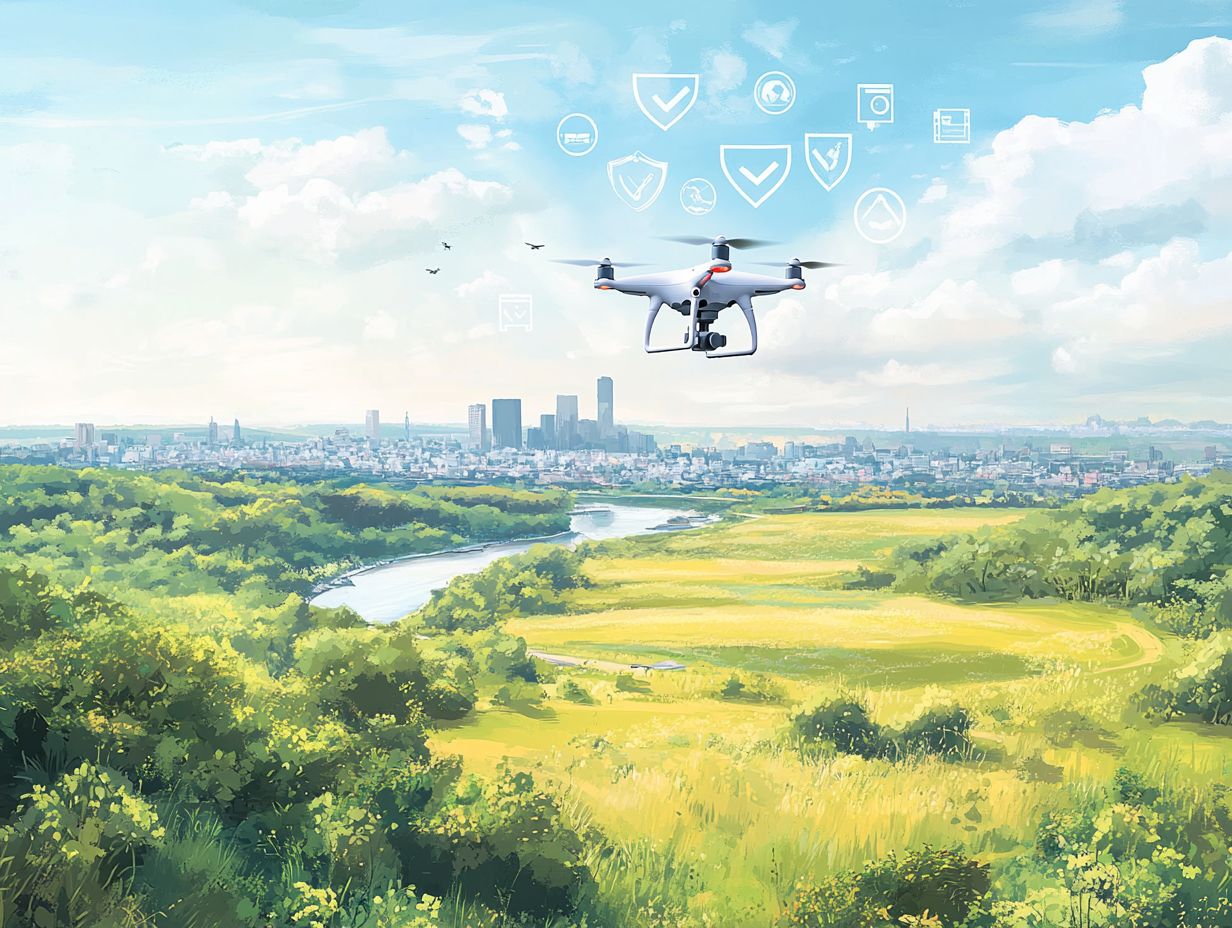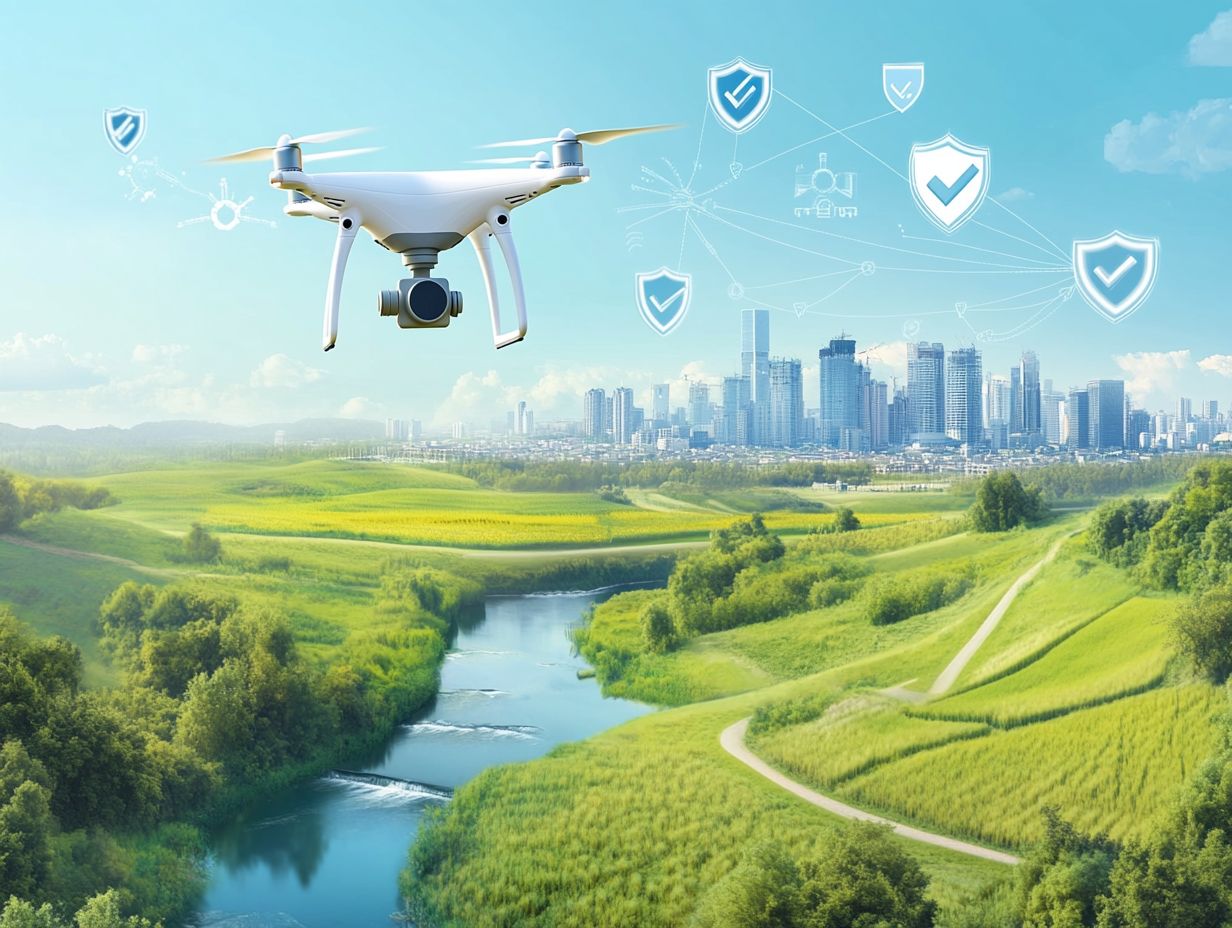What is Coverage for Drones?
As drones transform industries ranging from agriculture to cinematography, grasping the nuances of drone coverage becomes imperative for you.
This article delves into what drone coverage entails, its importance, and the various types available, such as liability and hull coverage. You ll discover the factors that influence coverage, including the type of drone you operate, its intended use, and the location of your operations.
We also offer insights on how to secure the right insurance and share tips for selecting the best policy tailored to your needs.
Continue reading to ensure that your drone operations are safeguarded effectively.
Contents
Key Takeaways:

Overview of Drone Coverage
Understanding the landscape of drone coverage is crucial for you. Whether you re a commercial operator or flying for fun, drone insurance shields you from various risks.
As drone usage grows, especially with providers like SkyWatch.ai, the need for comprehensive insurance policies becomes apparent. This overview highlights essential aspects like liability coverage and hull insurance.
What is Drone Coverage and Why is it Important?
Drone coverage encompasses various insurance policies tailored to protect you, the drone operator, from potential liabilities and risks associated with UAV (Unmanned Aerial Vehicle) operations, making it a crucial aspect of your risk management strategy.
Having drone insurance protects you against personal injury, advertising injury, and property damage. This type of insurance allows you to concentrate on capturing breathtaking aerial footage or executing vital commercial tasks without the nagging worry of unexpected expenses.
This insurance effectively mitigates risks, such as medical costs arising from accidents or injuries to third parties, which can escalate into significant financial strains. Liability worries, particularly regarding potential lawsuits or damage claims, are also addressed by these policies.
By investing in a solid insurance policy, you not only showcase your professionalism and responsibility but also safeguard yourself against the numerous challenges that may arise in the rapidly evolving world of drone usage. Therefore, the significance of drone coverage cannot be overstated for anyone serious about aerial operations.
Types of Drone Coverage
The realm of drone insurance offers a spectrum of coverage designed to cater to the unique needs of drone operators, ensuring comprehensive protection against the myriad risks associated with UAV operations.
Each insurance type plays a distinct role; for instance, liability insurance safeguards against personal injury and property damage, while hull insurance shields your drone from mishaps.
Specialized options like payload and ground equipment insurance ensure every part of your drone operation is protected, no matter its intended purpose.
Don’t wait ensure you have the right coverage today! Your peace of mind is just a policy away.
Liability Coverage
Liability coverage is the bedrock of drone insurance, offering essential protection against claims of personal injury, property damage, and even advertising injury. This coverage grants you peace of mind as an operator.
With drones becoming increasingly common across various sectors, securing liability insurance from reputable providers is imperative for anyone engaging in commercial operations or recreational activities. This coverage safeguards you against potential financial ruin stemming from accidents or mishaps during drone flights.
Imagine you re a drone operator capturing stunning aerial shots for a real estate agency. Then oops you accidentally crash into a passerby. That could lead to a hefty liability claim.
Or picture this: your drone surveys land but veers off course and crashes into a neighbor’s car. Without the right coverage, the financial fallout could be staggering.
Understanding the breadth of liability coverage is essential it can encompass bodily injury, damage to third-party property, and even complications arising from advertising claims, which refer to disputes related to marketing errors. Selecting the appropriate insurance provider guarantees comprehensive protection and access to valuable support services. This decision is crucial for anyone serious about their drone operations.
Hull Coverage

Hull coverage represents a specialized type of drone insurance designed to safeguard the physical aircraft from damages resulting from accidents, theft, or unforeseen events. As drone technology progresses, the demand for comprehensive hull insurance becomes increasingly paramount.
This coverage is essential whether you re engaged in commercial operations or enjoying recreational flights. It offers a safety net against potential repair or replacement expenses.
Consider a scenario where a drone used for aerial photography crashes due to pilot error or an unexpected mechanical failure when parts of the drone stop working unexpectedly. Hull coverage would step in to cover those repair costs.
Likewise, if a delivery drone is stolen during a routine drop-off, this protection would shield your investment from significant loss.
This insurance can encompass damages from collisions, water exposure, or even acts of vandalism. It highlights the necessity for operators to grasp the risks tied to their activities. Ultimately, hull coverage brings peace of mind and emphasizes the financial significance of securing these valuable and often complex machines.
Factors Affecting Drone Coverage
Several critical factors influence the cost and terms of drone insurance coverage, making it essential for you to grasp these variables to secure the best policy.
The type of drone you fly, its intended use whether for commercial activities or leisurely pursuits and your operation’s location are pivotal in shaping your insurance needs and premiums. By understanding these elements, you can select an insurance policy that effectively meets your unique requirements and risk profile.
Type of Drone
The type of drone you operate significantly influences the insurance coverage options available to you. Each model and configuration presents its unique risks. If you’re using high-end drones for commercial operations, you often need specialized insurance policies that cater to their specific capabilities and potential hazards.
On the other hand, if you’re flying recreational drones, your coverage requirements may differ. It’s important to select an insurance policy that aligns with your drone’s specifications.
For instance, if you have a large agricultural drone designed for crop monitoring, you may find that you need more comprehensive insurance. This is due to the potential for causing significant property damage or facing liability claims in rural areas.
In contrast, a small drone equipped with a camera for personal photography might only require basic liability coverage. If you operate in industries like real estate or construction, where drones are used for aerial surveys and inspections, you ll need policies that cover a broader scope of liabilities, including equipment damage and third-party injuries.
Understanding these varying needs is essential for ensuring that you have adequate protection. Don’t gamble your investment away! Get the coverage you need today to protect your drone and your peace of mind!
Intended Use
The intended use of a drone whether for commercial operations or recreational activities greatly influences the type and complexity of insurance coverage you ll require. For commercial UAV operations (Unmanned Aerial Vehicle), full liability insurance is often a must to protect against a range of risks, including personal injury and property damage.
In contrast, recreational use may call for more basic coverage options. Understanding these distinctions is essential for securing the right insurance policy.
For instance, if you re a commercial operator using drones for real estate photography, the stakes are considerably higher. Any mishap could lead to significant financial repercussions. This makes specialized policies that cover equipment malfunctions and third-party claims a necessity.
If you re simply enjoying your drone for personal pursuits, like capturing aerial shots in a park, a general liability policy might suffice, given the lower potential for extensive damages.
It s clear that while both commercial and recreational users must take liability seriously, the specific risks tied to their activities create vastly different insurance needs and considerations.
Location of Operation
The location of your UAV operations plays a crucial role in shaping your insurance coverage. Different environments introduce distinct risks and regulatory considerations. If you’re operating in high-density areas, you may need more extensive liability insurance due to a higher likelihood of property damage or personal injury.
On the other hand, rural locations present different risk profiles. Collaborating with FAA-licensed insurance providers is crucial to customize policies for your specific operational environment.
In urban settings, you might face heightened regulatory scrutiny. This necessitates coverage that addresses unique urban challenges, such as managing flight proximity to crowds or structures. Conversely, if you’re operating in less populated areas, your focus may shift to protecting against environmental hazards like wildlife interference or adverse weather conditions.
Regional variations in drone usage, shaped by local regulations and community needs, play a critical role in determining the type and extent of insurance coverage needed. Grasping these geographic nuances is essential for ensuring compliance and safeguarding your operations.
Obtaining Drone Coverage

Securing drone insurance involves a careful exploration of diverse options and a clear understanding of the specific requirements outlined by various providers. You need to evaluate your unique circumstances, taking into account the type of drone, its intended use, and the operational location to select the most appropriate insurance coverage.
Partnering with FAA-licensed insurance providers ensures compliance with regulations and secures the essential coverage needed to effectively manage any potential risks.
Insurance Options and Requirements
When exploring insurance options for your drone, familiarize yourself with the various coverage choices available, including liability insurance and hull coverage, along with the specific requirements set by insurance providers. Each policy comes with its own terms and conditions that you must meet for comprehensive risk management and adequate protection during your UAV operations.
Liability insurance typically covers damages arising from accidents involving your drone, effectively shielding you from lawsuits and claims related to bodily injury or property damage. Hull coverage safeguards your drone against physical damage from crashes, theft, or vandalism. It s wise to consider additional coverage options like payload insurance, especially if you transport valuable equipment during your flights.
Adhering to FAA regulations is crucial. Many insurance providers require proof that you re following safety guidelines and operational limits. This compliance not only fulfills your legal obligations but also strengthens your position as a responsible pilot in the eyes of insurers.
For tailored advice, consult an insurance expert who can help you navigate your specific needs.
Tips for Choosing the Right Coverage
Selecting the right drone insurance coverage might feel overwhelming. However, grasping a few essential tips can streamline the process and help you find the most suitable policy for your specific needs.
It’s crucial to evaluate your individual requirements based on how you intend to use the drone, the type of drone in question, and the location where you plan to operate. Comparing different policies and providers gives you the power to make informed decisions that align perfectly with your operational requirements and risk profile.
Evaluating Your Needs
Evaluating your needs is an essential step in selecting the right drone insurance. This allows you to pinpoint the specific risks associated with your drone operations. Consider factors such as the type of drone you operate, its intended use, and the environment in which you fly. These elements are critical in determining the coverage options necessary for you.
Engaging with seasoned insurance providers can offer valuable insights. They can help you craft a policy that aligns with your individual risk management strategies.
Understanding factors like how often you operate, the geographical zones involved, and potential third-party liabilities is vital in assessing your comprehensive insurance needs. For instance, if you’re a commercial user, you may encounter different regulatory demands compared to recreational pilots.
Analyzing past incident data can also illuminate potential vulnerabilities you may face. By thoroughly evaluating these various aspects, you gain a clearer view of your risk exposure and enhance your negotiation leverage with insurers.
This ultimately leads to more favorable terms and conditions that are tailored specifically to your unique operational scenarios.
Comparing Policies and Providers
When comparing drone insurance policies, it’s crucial to analyze the coverage options and terms from various providers. This helps you discover the perfect match for your operational needs.
Understanding the nuances of each policy can significantly enhance your level of protection. Evaluate aspects like specific coverage limits, exclusions, and any additional coverage options that could bolster your policy.
Don’t overlook the reputation for customer service of each provider, as this greatly affects your experience during claims processing. Seeking advice from knowledgeable insurance professionals can provide valuable insights into these details, helping you navigate the complicated jargon and ensuring that no essential elements slip through the cracks.
Ultimately, a thorough examination of these factors will lead you to make a well-informed choice.
Frequently Asked Questions

What is Coverage for Drones?
Coverage for drones refers to insurance policies that provide protection for individuals and businesses that own and operate drones or unmanned aerial vehicles (UAVs).
What types of coverage are available for drones?
- Liability coverage
- Hull coverage
- Payload coverage
- Personal injury coverage
Do I need coverage for my personal drone?
If you own a personal drone for recreational use, coverage may not be required. However, it is highly recommended to protect yourself from potential accidents or damage.
Who needs coverage for commercial drones?
Anyone who uses drones for business purposes, such as aerial photography, real estate, or surveying, should have coverage for their drones to protect their business and assets.
What does liability coverage for drones include?
Liability coverage for drones typically includes bodily injury and property damage caused by the drone, as well as legal defense costs in case of a lawsuit.
Is coverage for drones expensive?
The cost of coverage for drones can vary depending on factors such as the type and value of the drone, the intended use, and the coverage limits. It is best to compare quotes from different insurance providers to find the best coverage at a competitive price.
In conclusion, finding the right drone insurance can protect your investments and give you peace of mind. Consult with an insurance expert today or request a quote to ensure you have the coverage you need.






